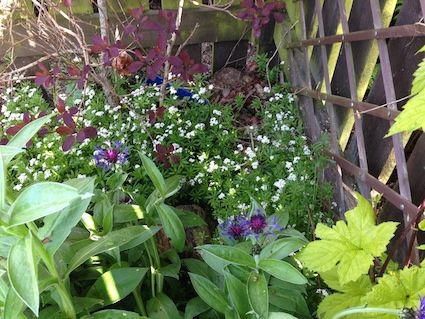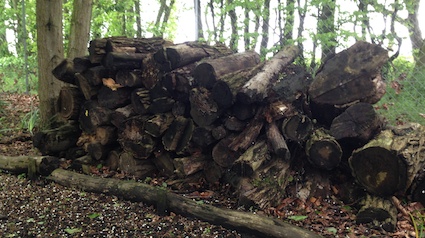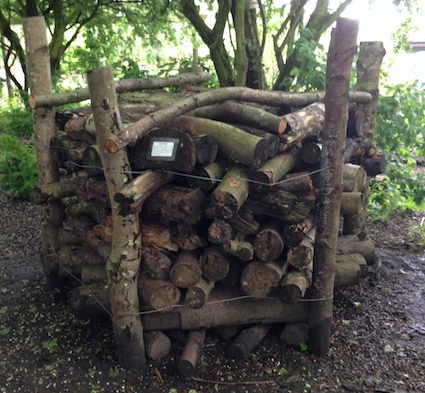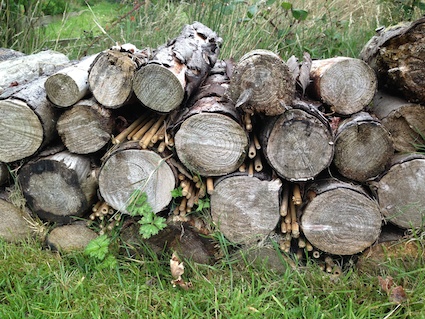In recent years the old-fashioned log pile has been superceded by the hip and trendy mini beast hotels in school grounds. Whilst these are a lovely form of recycling and repurposing of various materials this post is a plea to all schools to provide create lots of log piles within their grounds too.
When searching through my photos to create this post, I was surprised to find that I have almost no photos of log piles. The ones in this post all come from the Woodland Wildlife Garden at Martin Mere Wildfowl and Wetlands Trust Centre, other than the one in the photo below which is from a corner of my own garden and is now well-hidden at this time of year. I suspect this is because they never look especially interesting. The log piles at Martin Mere caught my attention because they are all slightly different structures. There were also several of them, which sends a positive message. Lots of log piles provide lots more homes for wildlife.
In woodlands, dead and decaying wood is a natural occurrence and provides an essential habitat for lots of wildlife within this ecosystem. It is a home and a source of food for many animals. Log piles mimic fallen trees. They provide a shelter for hibernating small mammals and insects. The worms and grubs provide food for birds and mice. All sorts of interesting fungi can end up growing there. Within a year or two, a wildlife community can be created in and around a log pile.

Where is best to site a log pile?
There are a few things worth doing to increase the wildlife value of a log pile. Firstly, think about where they will be situated.
- Put them near to other wildlife features to help create a wildlife corridor where animals can move around the neighbourhood in safety. I’ve put a small bird-bath sized container near my log pile so that there is a water source for wildlife. My neighbour has a long hedge through the fence. Another neighbour has a nearby tree. In my own garden around this area are lots of wildlife friendly plants such as yarrow and red campion.
- Damp places are favoured by many forms of wildlife. By stacking a log pile carefully, drier habitats can be created towards the top of the pile.
- Shade is also useful because it helps mimic the shadier environment of a woodland floor. So log piles work nicely in a north-facing area of your grounds. Put it in a quieter part of the grounds away from the hustle and bustle of playtime activities such as football.
- If the log pile is situated near a pond, then it can provide useful shelter and protection for amphibians.
- Avoid putting a log pile very close to healthy trees and shrubs. Fungi, bacteria and diseases can be harboured in rotting logs which may be transferred to the living trees and cause damage.

How do you make a log pile?
Perhaps surprisingly, a good log pile is more than just dumping a few random logs into an area. As a general rule, the bigger the log pile, the better. There’s more room inside for wildlife. It stays warmer in winter. It is likely to suffer less disturbance. However make sure the structure is secure and won’t topple over unexpectedly.
Use a mix of native species of wood. This includes species such as oak, birch, rowan and Scot’s Pine. Different wood types appeal to different creatures and decay at different rates. Keep the bark on the wood.
Do not pinch decaying wood from woodlands – it’s a home for wildlife there too. Instead ask your local ranger service or Forestry Commission or a friendly tree surgeon business for advice about sourcing wood including some rotten pieces which can help kickstart the decay process.
Bury some logs upright into the soil as this can appeal to underground hibernators. Also, where possible, bury the first horizontal logs at the bottom of the pile a few centimetres into the soil level in a shallow pit to allow migration between the soil and the logs. It also helps keep the logs nice and damp.
Have bigger logs in the middle of the log pile and increasingly smaller ones towards the edges. Place a few logs at the edges which will be used by classes who wish to look at minibeasts in the log pile. This means they can do so without disturbing the main part of the pile. You may wish to add a a square or two of old carpet nearby too so that these can be lifted and examined.

How do you maintain and care for a log pile?
- Try and leave the log pile alone. This is the golden rule.
- Growing climbing plants to clamber over the wood pile such as brambles and honeysuckle can help discourage people from disturbing it.
- To beautify the log pile, plant woodland plants around and near it. Spring flowering bulbs such as snowdrop, crocus and bluebell along with perennials.
- If you are able to drill random holes in the logs, then solitary bees may appreciate this instant home. Alternatively, in the photo below, you can see bamboo canes have be added in some places.
- Keep adding new logs as the old ones decay. This does not happen overnight. An annual check is usually enough here.
- In autumn, create a pile of leaf litter nearby to attract a wider variety of wildlife. Toads and hedgehogs like to hibernate in leaf piles.

I would love to hear from schools which have log piles happily nesting in a quiet corner of their school grounds. I’m a little concerned that this practice is becoming less common than in the past.
This blog post was originally published in May 2014.




















Great advice Juliet. We inadvertently created a rotting log pile when our seating stumps on the bark chipping became soft with the damp etc & began to rot – the children love watching all the beasties that are living in them but they do seem to to attract big wasps so I had to get rid of some of them. I think we’ll create a proper log pile house (fit for a snake!) up in Bear Woods.
Hi Kierna
Emily Danby from The Natural Playground (@Natplayground) has raised the valid point about the power of children creating their own log piles and how much the children at her sessions value their creations. I think this is worth remembering when creating log piles too.
Best wishes
Juliet
Reminds me of Hugelkultur style garden beds! Great idea!
Brianna
I had to look up “Hugelkultur” – it’s a great concept – thanks for raising my awareness http://www.diynatural.com/hugelkultur-raised-garden-beds/
Hi there, i would love to create a log pile in my garden but i am confused as to whether or not i should plant around it? because at first you advise not planting around it or placing it away from live plants because of the possible dangers of bacteria from the dead wood, but later on you suggest planting around it to make it look more beautiful??? Which do i do???
Thanks for any advice,
Mark
Hello Mark
I’m sorry the advice has confused you! Rotting logs may harbour fungi, bacteria and diseases which may harm healthy trees if in close proximity. Thus siting them a little further away from trees and bushes rather than piled up against the trunk of a healthy tree. Bulbs and other flowers should not be affected by rotting would and thus can be planted beside the log piles. I hope this clarifies. However if I’m mistaken, I hope someone will care to correct me!
Best wishes and hope you do create a log pile.
Juliet
Is it possible to start a wood pile using the netted bags of dried firewood that you can buy at petrol stations?
Good question. I would presume so, as I’m not aware that any other chemicals, etc. have been added. However bear in mind that you don’t know where these logs have been felled. As much as possible I would go for using logs that are in the local vicinity. So you’re probably better off sourcing logs from a local sawmill or firewood supplier.
Hi do you think it would be safe to stand part of an old dead branch against a wooden shed ? Worried about what you say about the bacteria etc
Thanks for any advice
Terri
Hi Terri
I presume you are referring to this comment “Avoid putting a log pile very close to healthy trees and shrubs. Fungi, bacteria and diseases can be harboured in rotting logs which may be transferred to the living trees and cause damage.”
So a rotting wood pile close to a living tree is a something to be mindful of. But an old branch against a wooden shed (which is not living) is probably fine. However do seek a 2nd opinion as I’m not sufficiently knowledgeable about bacterial breakdown within wood.
Best wishes
Juliet
I know this is 10 years on but need advice please.
I have had a large wood pile in my garden for about 30 years now but it is actually pushing my neighbours fence over and she asked me if I could move it! if I have to what is the best time of year for this to happen? Many thanks Chris
Probably over winter – just check for hibernating creatures in advance.